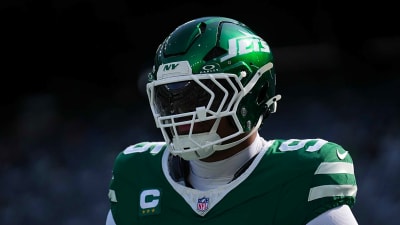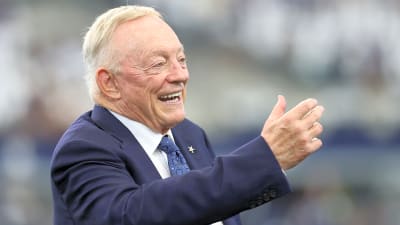
Birds, bump drafts and 'Big Ones': At Daytona, luck, fate play a huge role
Few sporting venues have the mystique of the Daytona International Speedway.
Since 1959, the 2.5-mile track has served as home of NASCAR's most prestigious race, the Daytona 500 — the first race on the NASCAR Cup Series schedule (Sunday, 1:30 p.m. ET, Fox). The "Great American Race" is consistently NASCAR's top TV draw (h/t: Front Office Sports), perhaps because the inherently chaotic nature of the racing mean fate and chance often have more to do with determining a victor than the skills of a driver and his crew.
Drivers, of course, must be at least a little lucky to win any auto race. But factors they and their crews can't control at Daytona make for what ARCA Menards Series driver Ryan Roulette described as "a game of chess" at 200 miles per hour. Seemingly mundane events during a race — a piece of debris in the wrong spot on a track, a wayward seagull striking a car or a bump draft gone wrong — can determine the outcome of the Daytona 500.
Drivers and crew chiefs often fret over how little they control during a race at Daytona. The biggest culprits are the unforgiving, snarling packs created by drafting and violent, vicious "Big Ones" — auto racing parlance for wrecks involving 10 or more cars.
Daytona is not unique for its pack racing. It's not unique for crashes, either. However, the venue's narrow racing surface — 40 feet compared to Talladega's 48 — makes it much harder for drivers to avoid crashes often triggered by the 20-plus car packs.
In recent years, the "Big Ones" have only increased in scale. In 2024, contact from William Byron, who won the race, sent Brad Keselowski around in front of the entire field. The crash involved more than a dozen drivers, many of whom were left with nowhere to go as the wreck played out in front of them.
The "Big One" in the 2024 Daytona was caused by a chain reaction that started with a poor bump draft, a move that can win races if done correctly and dash dreams if done poorly.
Bump drafting with a fellow driver in the wrong spot on the track — in a corner, for example — could be the difference in whether or not a car comes back to the pits in one piece.
Dale Earnhardt's Daytona woes
No man fell victim to the unknowns of Daytona as much as one of auto racing's greatest drivers, Dale Earnhardt. He won qualifying races, as well as the Busch Clash and Xfinity Series races, at the track. But for 20 years, a Daytona 500 win eluded him, often in cruel fashion.
In 1986, Earnhardt ran out of gas in the closing laps. In 1990, a flat tire caused by debris in the final corner doomed him. On the second lap in 1991, "The Intimidator" struck a seagull, which blocked air from getting into the engine. It was removed during a pit stop 30 laps later, averting a potential major problem.
In 1997, Earnhardt fell victim to one of Daytona's infamous "Big Ones." In that instance, Earnhardt's No. 3 barely wiggled out of a groove and brushed the wall. Then contact from Dale Jarrett sent Earnhardt upside down, ending his chances of winning the race. In true Earnhardt fashion, the seven-time Winston Cup champion somehow got his Monte Carlo to crank. With the help of duct tape, Earnhardt finished 31st.
On Feb. 15, 1998, a year after he had barrel-rolled down the Daytona superstretch, Earnhardt finally exorcised his Daytona 500 demons thanks to another one of race's infamous unknowns: the timing of cautions. If they fall on the final lap, they either can make you a hero or a victim of circumstance.
In 2024, Byron was leading as the field came to take the white flag. Ross Chastain raced in second, desperate to make a move. As the field roared into the tri-oval, Chastain threaded the needle, forcing a three-wide move that sent Chastain's No. 1 car and Austin Cindric's No. 2 spinning across the infield grass.
When the caution flag flew, Byron barely edged his Hendrick Motorsports teammate for the win. Earnhardt earned his lone Daytona 500 triumph in similar fashion.
After Lake Speed and John Andretti went spinning on the backstretch with two laps to go, Earnhardt maneuvered around the lapped car of Rick Mast and held off a hard-charging Bobby Labonte to take the white and yellow flag together. With no NASCAR overtime in 1998, Earnhardt coasted to his long-awaited celebration.
Earnhardt's victory in the 1998 Daytona 500 is considered one of the greatest wins in NASCAR history. Atop Earnhardt's pit box that day was Larry McReynolds, who recently explained the challenges of driving at Daytona.
"You can go to Talladega or Daytona and have the fastest car, best- handling car, the fastest pit stops and perfectly executed strategy," said McReynolds, an analyst for Fox's NASCAR coverage, "but the outcome of your race can come down to one move your driver or another driver makes in the last corner of the last lap.
"As a crew chief, at those two tracks, once you made your final pit stop, you just sit on the pit box and watch the race unfold as fans do," he continued. "You know then that there is nothing you can do or say on the radio that can change the outcome of your race. It is totally up to your driver and spotter at that point."
Mystery and magic
Daytona's evolution is one of the more intriguing in NASCAR history. Before the days of restrictor plates and pack racing, the Daytona 500 was a race in which the best strategy and a fast car were all a driver needed to take home the sport's biggest prize. But NASCAR historian Ken Martin said the mystery and magic of Daytona have always existed.
Martin's first experience at a race in Daytona Beach came before the speedway was built. He attended the final race at the famous Daytona Beach Course in 1958, the year before NASCAR founder Bill France Sr.'s magnificent, new track opened.
"When the Daytona International Speedway opened in 1959, it was surrounded by unknowns," Martin said. "In those first 500 miles, stock car racing changed forever. When the teams arrive in 2025, there will again be unknowns. Although the sport has evolved from backyard engineers to [computer-driven] simulations, the race is still a calculation of strategy, speed, skill and luck."
Of course, you still need a great car and a great driver to win at Daytona, but Martin noted luck for good reason. It's often a must-have for a driver to reach the Daytona 500's iconic victory lane.
'The majority of things are out of your control'
The sages of NASCAR have done their best to pass on advice for conquering Daytona's notoriously high banks, but the new generation of drivers is the generation perhaps most in danger of falling victim to Daytona's unknowns.
NASCAR Craftsman Truck Series driver Layne Riggs found that out the hard way in his Daytona debut in the 2024 Truck Series season opener. Riggs' first Daytona start lasted only 13 laps because of a Daytona "Big One" early in the race.
"Racing at a superspeedway, the majority of things are out of your control," Riggs said. "The only thing you can really control is the line you're in, how aggressive you can be and knowing when to make aggressive lane changes."
"I haven't completed a superspeedway race yet. My goal is to finish Daytona this year."
Perhaps the only comforting words Riggs and his fellow drivers could be offered just before the start of a race at Daytona are ...
"Start your engines!"
"And good luck."
All quotations obtained firsthand unless otherwise noted.
More must-reads:
- Bubba Wallace takes Duel 1, will start third at Daytona 500
- Photo finish decides Duel 2 at Daytona, Corey LaJoie races into Daytona 500
- The 'World Series MVPs' quiz
Breaking News
Trending News
Customize Your Newsletter
 +
+
Get the latest news and rumors, customized to your favorite sports and teams. Emailed daily. Always free!








